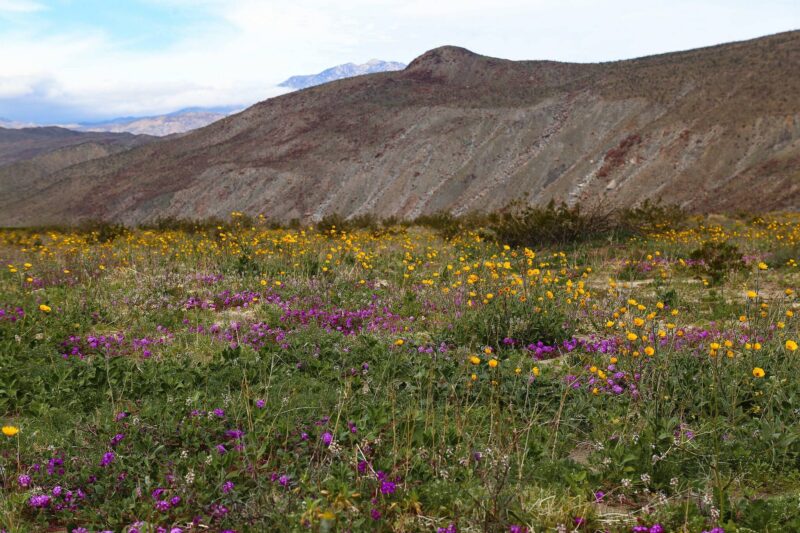Following California’s relentlessly wet winter, locals and visitors alike are being treated to a spring “super bloom” – a floral extravaganza of native wildflowers.
The unpredictable wildflower blooms occur when a rainy season drenches natural areas following a years-long drought that’s eliminated grasses and weeds that take up nutrients, explains the California Department of Parks and Recreation.
How the bloom develops will depend on continued weather conditions, but depending on the park, visitors could see the countryside awash in bright orange California poppies, sand verbena, desert sunflowers, evening primrose, popcorn flowers or desert lilies.
The blossoms largely start inland in the desert in late winter, then work their way through higher elevations and coastal regions. “High-elevation mountain regions don’t show their flower power until long after snowmelt, typically mid-July,” notes information from Visit California.
Because the timing of the bloom will vary according to ever-evolving weather, it’s a good idea to check before you head out with camera in-hand. Resources include the individual parks’ websites and social media pages that often offer updates, the Theodore Payne Foundation Wildflower Hotline
Featuring parks from the Bay Area to SoCal, you’ll find tips on how to get there – including whether four-wheel drive is recommended, for example – and what you’ll likely find when you do.
Popular areas in later spring include the Antelope Valley California Poppy Reserve State Nature Reserve and Red Rock Canyon, along with Hungry Valley State Vehicular Recreation Area and Fort Tejon State Historic Park, expected to have larger blooms in later spring.
Near Redwood City Russian Ridge Preserve boasts orange poppies and blue lupine, before mule’s ears, brodiaea and farewell-to-spring offer blossoms well into May.
Don’t tread on the flowers… and other essentials
As with any spectacle, the crowds hoping to take in the spring bloom can create problems for sensitive ecosystems, and authorities urge visitors to be mindful the landscape they’re exploring.
“California State Parks welcomes all to enjoy these unpredictable, rare occurrences but asks visitors to ‘Don’t Doom the Bloom’ by staying on designated trails and taking only photos, not flowers,” says State Parks Director Armando Quintero.
Here are a few tips for enjoying bloom time in California:
- Be prepared: Download a map andprepare for the landscape you’ll be visiting – especially in the desert – and be ready for changeable weather. Cell coverage can be spotty or nonexistent, and roads may require four-wheel drive to navigate. Leave an itinerary of your trip with family or a friend, including your destination and route, the names of everyone in your group, and when you expect to depart and return.
- Plan ahead: Beat the crowds by visiting parks during the week and arriving early. Note that you’ll rarely find restaurants, gas stations or stores near bloom areas, so bring plenty of food and water to remain hydrated and avoid heat-related emergencies. Weather can change quickly – especially in the mountains and desert – bring sunscreen, a hat, layers of clothing and closed-toe shoes to avoid injury.
- Respect others: Pull off the roadway when viewing wildflowers, wildlife or to take photos, ensuring you leave roadways clear for vehicle traffic.
- Respect the landscape: Stay on designated trails whenever possible – do not trample flowers or other flora, and where dogs are permitted, keep them on a leash (Do not leave animals in vehicles as temperatures can quickly turn lethal). Pack out anything you brought in and note that picking flower picking is prohibited – take only pictures.
If you go: Plan your visit to California’s spring wildflowers at parks.ca.gov/WildflowerBloom.
Plan your adventures throughout the West Coast at westcoasttraveller.com and follow us on Facebook and Instagram @thewestcoasttraveller. And for the top West Coast Travel stories of the week delivered right to your inbox, sign up for our weekly Armchair Traveller newsletter!











 A puzzle inspired this Victorian-style bed-and-breakfast in Lake Stevens
A puzzle inspired this Victorian-style bed-and-breakfast in Lake Stevens